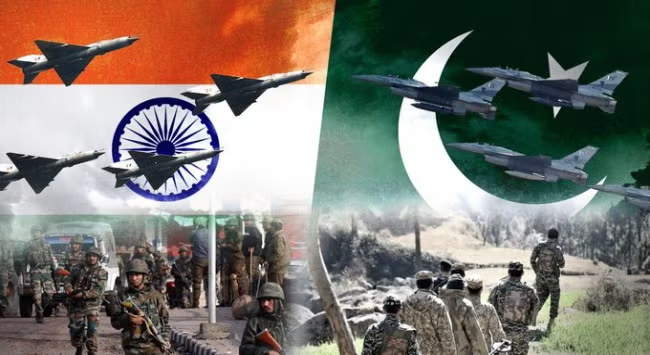India’s precision air strikes on critical Pakistani airbase on May 10 not only delivered a crushing blow to Pakistan’s aerial capabilities but also signalled a decisive turn in the four-day escalation between the two nuclear-armed neighbours.
As Indian missiles obliterated vital runways and struck uncomfortably close to its nuclear arsenal, Islamabad was sweating bullets. Within hours of the coordinated strikes, an alarmed US was forced to intervene and a cornered Pakistan made urgent overtures for a halt to all military actions. It was advantage India.
India’s response came hours after a Pakistani missile and drone attack targeted 15 Indian airfields and garrisons across Jammu and Kashmir to Gujarat. The assault, which killed 16 civilians and damaged religious structures, followed New Delhi’s offer to Islamabad to open communication channels aimed at de-escalation.
After that, retaliation was inevitable—one designed to hit Pakistan where it hurts.
India targets Pakistan’s military infrastructure
In a pre-dawn operation on May 10, the Indian Air Force (IAF) struck 11 military sites deep inside Pakistan using air-launched precision weapons. The targets included critical airbases in Rafiqui, Murid, Nur Khan, Rahim Yar Khan, Sukkur, Chunian, Pasrur, and Sialkot, the Ministry of Defence said.
Satellite imagery later confirmed the extensive damage, showing destroyed hangars and blown-up air strips. A strike on Rahim Yar Khan airbase left a massive crater on the runway.
In Pasrur, Chunian and Arifwala, air defence radars were damaged, satellite images shared by the Indian armed forces showed.
Strategic significance of strikes
The strike on Nur Khan airbase in Chaklala, near Rawalpindi, carried significant strategic weight. The base is home to Pakistan’s main transport squadrons and vital for logistical and strategic airlift operations, housing aircraft like C-130 Hercules and IL-78 mid-air refuelers.
More critically, Nur Khan lies in close proximity to the headquarters of the Strategic Plans Division, the body overseeing Pakistan’s nuclear arsenal.
The New York Times quoted a former US official familiar with Pakistan’s nuclear programme, noting, “Pakistan’s deepest fear is of its nuclear command authority being decapitated. The missile strike on Nur Khan could have been interpreted… as a warning that India could do just that.”
Satellite imagery also indicated a strike on the runway of Mushaf airbase in Sargodha. This base is reportedly linked to underground nuclear storage sites beneath the Kirana Hills and was struck with multiple loitering penetrating munitions.
India’s Air Marshal AK Bharti later denied hitting Kirana Hills and “whatever is there.”
These strikes on Nur Khan and Sargodha were not merely retaliatory; they served as a calculated signal to Pakistan about India’s capability to neutralise its nuclear arsenal if the conflict escalated further.
Panic in Islamabad and US intervention
According to government sources, the Indian strikes triggered panic in Islamabad.
That same day, Prime Minister Shehbaz Sharif convened an emergency meeting of the National Command Authority, the apex body responsible for operational decisions regarding the country’s nukes. While Pakistan later denied the meeting, the reports highlighted the impact of India’s assertive action.
In Washington DC, Trump administration officials worried about the conflict spiralling out of control. The New York Times reported that US Vice President JD Vance, who had previously stated the conflict was “none of our business,” called Prime Minister Narendra Modi, urging de-escalation and direct engagement with Pakistan.
Meanwhile, Secretary of State Marco Rubio spoke to Pakistan’s Army Chief Asim Munir and then External Affairs Minister S Jaishankar, government sources said.
Rubio conveyed that the Pakistanis were willing to stop firing, and would India agree. Jaishankar responded: “If they don’t fire, we won’t fire.”
Subsequently, the Pakistani Director General of Military Operations (DGMO) reached out to his Indian counterpart through established channels, seeking a ceasefire.
The damaging air strikes on key airbases effectively cornered Pakistan, leaving it with little option but to stand down and parley for a pause in the fighting. This gave India the strategic upper-hand and paved the way for a fragile truce on its own terms, albeit with a nudge from the US.
Operation Sindoor represents a marked shift in India’s strategic approach towards Pakistan. By striking deep into Pakistan’s heartland, targeting strategically important areas like Punjab province, it altered the terms of engagement.








































